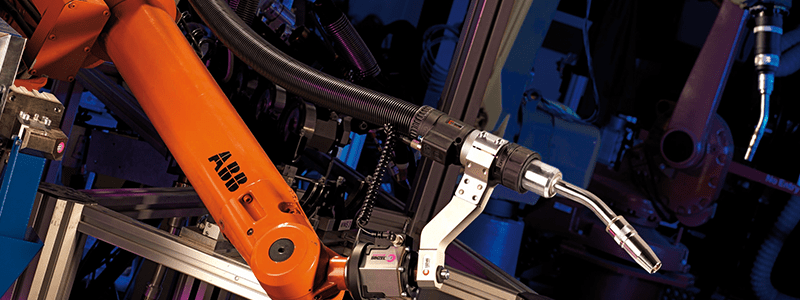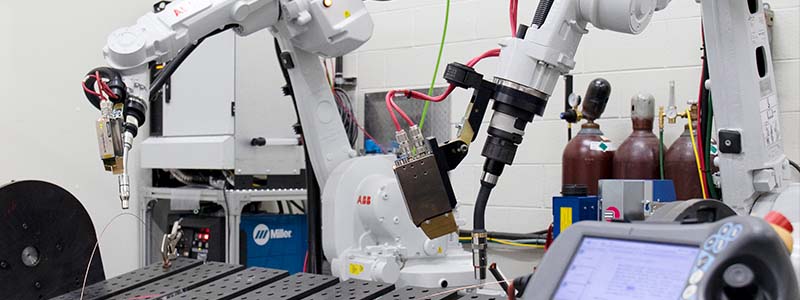In today's fast-paced environment, companies are constantly on the lookout for innovative solutions that drive productivity while also minimizing costs. In the world of welding, collaborative robots (cobots) have emerged as a promising solution, gaining widespread traction. Businesses around the globe are discovering that cobots offer a versatile and cost-effective way to boost efficiency. In today's blog, we're going over some of the ways that cobots can increase your ROI and maximize your savings.
Scott Huber
Recent Posts
How to Maximize Your ROI With Cobot Automation
Topics: Robotic Welding, Automation
Robots & Robotic Welding Torches | ABB Robotics x ABICOR BINZEL
As technology advances, your workplace must adapt to keep up with the need. That period of adapting will look different for everyone, as some operations needs are on a much smaller scale than others. For those in larger manufacturing plants, the push to automate has become a more prevalent move. Productivity is the name of the game and to keep up, operations must be able to repeat their tasks quickly and efficiently.
Topics: Robotic Welding, Automation
Seam Tracking and Welding Peripherals: ABICOR BINZEL x Yaskawa Motoman
With the current state of the welding industry as it sits now, we are seeing a lot of manufacturers moving away from manual to create a more automated process. With this comes a host of new welding equipment that can benefit your process, from improving repeatability and traceability, to increasing productivity and general performance.
Topics: Robotic Welding, Automation
Seam Tracking and Automation Solutions | BINZEL x ABB Robotics
When it comes to providing value through collaboration, the duo of ABB Robotics and ABICOR BINZEL does just that by innovating and integrating automation solutions for you.
With a top-of-the-line ABB robot, with welding torches and peripherals added to the table from BINZEL, customers can be sure they are receiving the highest-quality welding equipment available.
Topics: Robotic Welding, Automation
Keys to Wire Feeding In Automated Robotic Welding Applications
Wire feeding is a critical part to your automated welding process. Without functioning wire, this multi-layered, complex process would not deliver optimal performance. This could lead to complete failure of your process. Challenges can arise due to wire feed speed, wire feed distance, and friction within the system causing a host of problems throughout your process. As you continue to understand your robotic welding cell, it is important to evaluate your wire feed practices.
Topics: Robotic Welding, Automation
Weld Joint Finding Methods Explained
When we look at weld joint detection and the benefits involved, there are two primary features of these technologies: the finding and tracking of the joint.
Topics: Seam Tracking
How Seam Tracking Solutions Compare
Looking at Seam Tracking means looking at a variety of possible solutions. Depending on your process, material, and cycle time needs, the right solution will usually present itself over time.
But with if you aren't aware of ALL the solutions available?
Or just know about a couple?
Topics: Seam Tracking
Why Electronic Gas Management is Poised to Improve the Cost of Welding Gas
Gas delivery and gas management is inefficient and in need of some innovation. Looking at the landscape of gas delivery and gas management optimization, there’s very little invested or innovated in the actual deliverance of gas from supply tank through the control device and out the welding nozzle.
Topics: Shielding Gas
Gas Management System EWR 2: Frequently Asked Questions
When version one of the Electronic Welding Regulator EWR was released, we received a lot of questions about it's performance and how exactly it works to control the flow of shielding gas.
Now with version 2.0 of the EWR out - the EWR 2 / EWR 2 Net - we wanted to answer some of the frequently asked questions we received on the original EWR and update it for the next generation of gas management:
Topics: Shielding Gas
Optical Seam Tracking & Hard Automation
Hard automation in the past has always been about joystick controllers and a birds nest operator controlling the movement of the gantry or positioning system to guide the welding arc through the weld piece. And incorporating seam tracking into this solution? Leave that to the robots.
Today, however, optical seam tracking is finding itself now more than ever a real solution and added value to those hard automation processes, and leading old-school, analog welding operations to look at seam tracking technology in a different light.
Topics: Seam Tracking, Hard Automation










